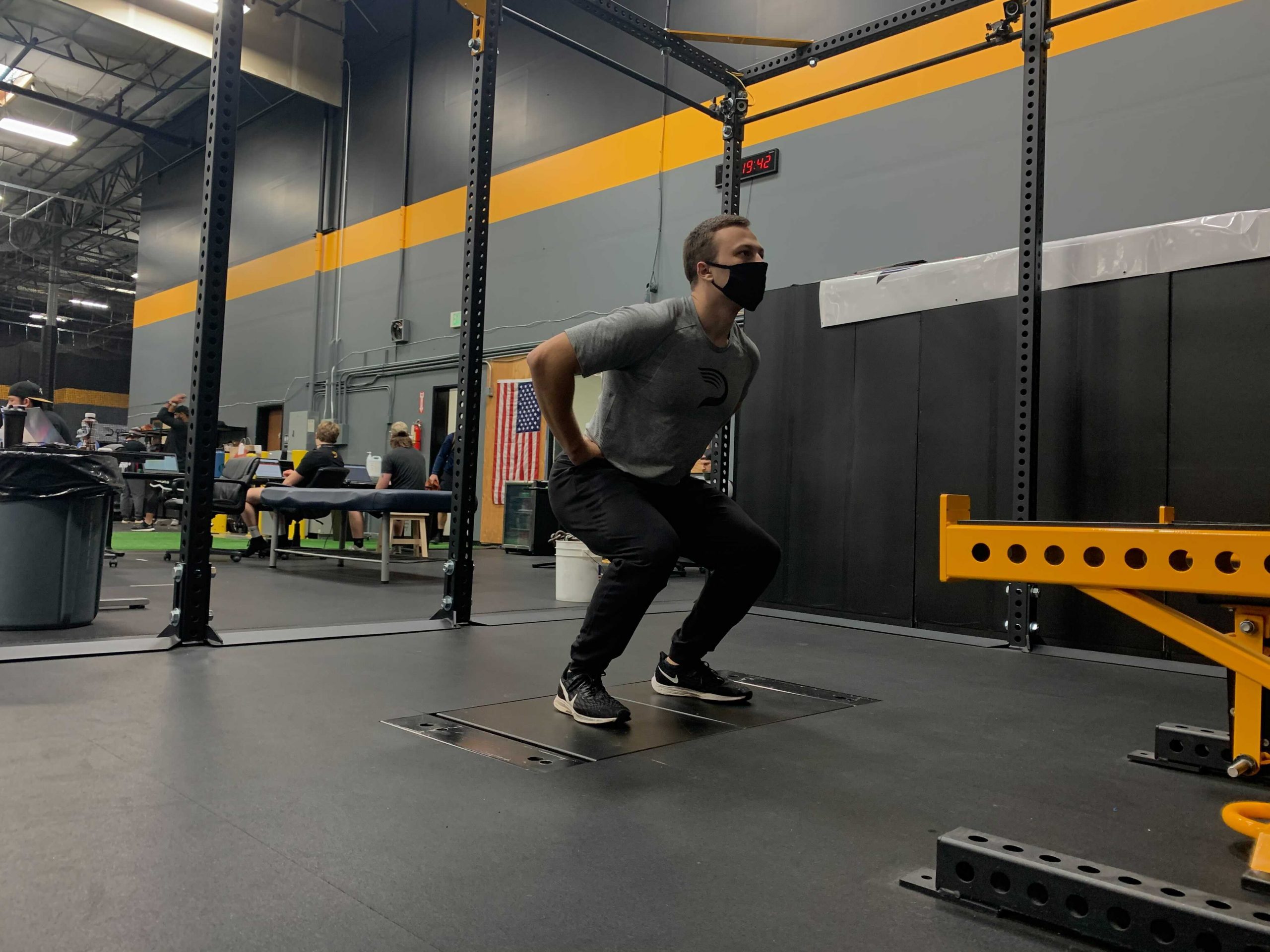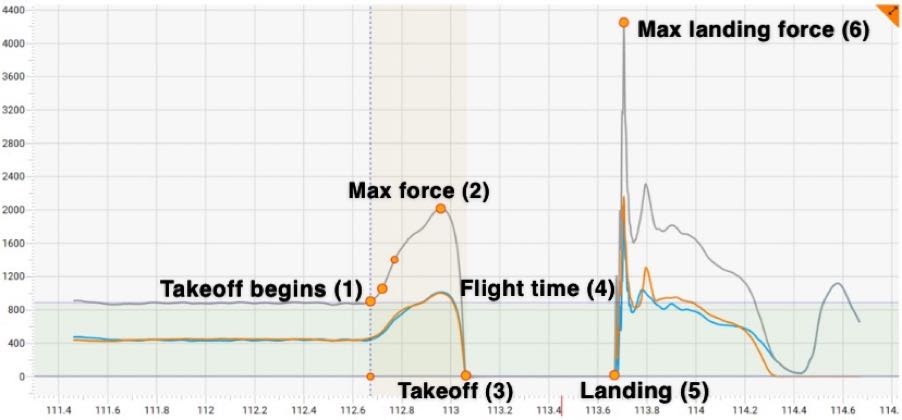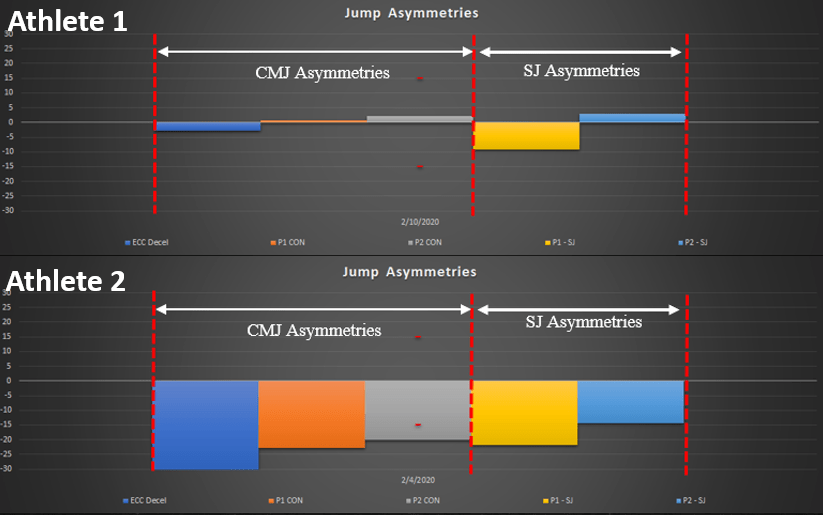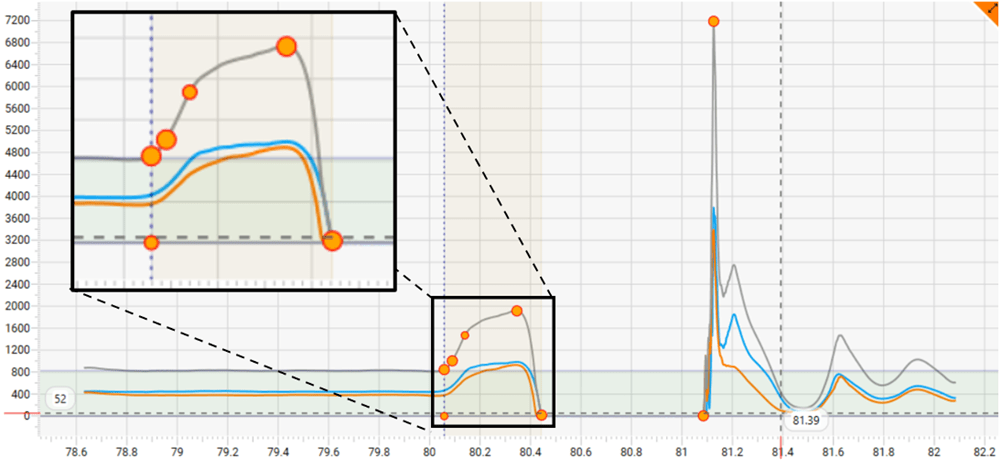What is the Squat Jump Test and why use it?

If you haven’t read our High Performance assessment summary blog, it is a good place to start.
The Squat Jump (SJ) test is used to assess lower-body concentric power. Squat Jumps are specific to strength and explosive sport competition, as many actions start in a static position (Haun, 2015). Removing the stretch-shortening cycle (SSC) from the jump test helps us better understand an athlete’s ability to overcome inertia from a still starting position.
The Squat Jump is important to include in conjunction with the Countermovement Jump (CMJ) test because the Squat Jump test is more sensitive to fatigue levels. The CMJ can “mask” lower extremity force production due to the utilization of the SSC. (Haun, 2015). Testing athletes, both with and without the SSC, gives us a broader picture of their current physical properties and what they may need to work on moving forward.
The variables analyzed in our Squat Jump test are:
- Jump Height
- Flight Time
- Peak Power
- Right and Left Leg Asymmetries
Squat Jump Protocol
The current protocol for testing an athlete in the Driveline Squat Jump goes as follows:
- Briefly explain the setup and execution of the drill. We aim to keep the drill explanations as short as possible so that the athlete can focus on solely jumping as high as possible.
- The athlete is told to sink into a half squat position at roughly 90 degrees with hands on hips.
- Have the athlete hold this position for roughly 3 seconds to alleviate the benefit of any elastic energy or the use of the stretch-shortening cycle.
- After about 3 seconds, give the athlete a “ready, go” call.
- Once the athlete hears the “ready, go” call, they jump straight up, as high as possible, with no countermovement at the bottom, keeping hands on hips, and then land back down on the force plates.
We aim to get four acceptable trials from each athlete’s Squat Jump test. Unacceptable readings occur if:
- The athlete has countermovement in the bottom position.
- The athlete removes their hands from their hips at any time during the jump -The athlete does not hold the bottom position for long enough.
- The athlete does not land with both feet on the force plates.
Force Trace and Force Trace Explanation
Figure 1 is an example force trace of an athlete performing the Squat Jump.
Prior to takeoff is the quiet phase. This is where the athlete squats down to 90 degrees and holds the bottom position for three seconds. The significant markers of the SJ are in the following points:
- The athlete begins the propulsive phase, which is the concentric part of his jump, and starts to apply force into the ground.
- The apex of the concentric phase trace, the maximum force produced during the jump.
- The athlete is airborne and is in the flight phase.
- The gap between points 3 and 5 is the time the athlete is in the air or flight time.
- The athlete then touches the force plates, which starts the landing phase.
- Peak landing force of the jump is achieved.
You can also observe that lines are representing each leg and total force throughout the jump. Orange is the right leg, blue is the left leg, and the grey line is the total amount of force between the left and the right legs.
Leg Asymmetries
Another highlight of the SJ test is in identifying athlete lower-body asymmetries. Assessing asymmetries during a squat jump can help identify imbalances or other potential issues that a strength coach may want to address in the athlete’s programming. It’s not unusual for athletes to display small asymmetries in their jumping patterns—especially considering that baseball is a rotational sport where athletes are frequently rotating in one direction over-and-over again.
Therefore, some level of asymmetry is expected, and in fact, normal – some slight asymmetries may be functional adaptations that help an athlete perform their skill. We generally want to see asymmetries within 15 percent in jumping patterns. In the figure below, the x-axis represents symmetry between legs, and each line above or below represents an additional 5 percent asymmetry.
Below the axis means the athlete favors their left leg, and above the axis means the athlete is favoring their right leg.
Figure 2 shows the jump asymmetries of two different athletes.
As you can see, both athletes display asymmetries in their jumps. Athlete 1 has very minimal asymmetries, while Athlete 2 has more severe asymmetries and heavily favors his left leg.
Figure 3 shows us a closer look at right and left leg asymmetries in the force trace.
As you can see in this image, the athlete is putting more force into their left leg (blue) than they are on the right leg (orange).
Practical Application of the Squat Jump
Using force plates to assess the Squat Jump can provide us with a number of insights that we can leverage to create better programs for our athletes. For example, a study by Nagahara et al. 2014 found that the squat jump had a significant correlation to the acceleration phase (6th to 10th steps) of sprinting, conceivably because concentric strength and power is a significant factor contributing to acceleration.
Therefore, an athlete who scores poorly in the squat jump may benefit from concentric strength & power training. However, it also important to consider other factors – such as an athlete’s body composition. If an athlete carries too much body fat, improving body composition may yield greater improvements to jump height and sprint speeds than a program focused on concentric strength and power qualities.
For a second example, we can compare an athlete’s squat jump height to their countermovement jump height. This is known as the Eccentric Utilization Ratio (EUR) and is calculated by dividing countermovement jump height by squat jump height (CMJ / SJ = EUR).
If an athlete’s jump squat jump height is significantly lower than their countermovement jump height, that is theoretically a strong indication that the athlete is highly reliant on the stretch-shortening cycle to produce explosive movement and may be lacking concentric strength and/or power. Therefore, it may be sensible to bias training to include lifts that develop these qualities.
An Olympic lifting variation where the athlete pulls from the floor or blocks may be preferable to a hang clean or hang snatch. A trap bar deadlift may make more sense than an RDL. A non-countermovement box jump may be better than a regular box jump. As a general rule of thumb, we would like to see athletes jump 10 to 20 percent higher in a countermovement jump compared to the squat jump – a EUR of 1.1-1.2. If the gap between the two is much higher than 20 percent, it may indicate that the athlete could benefit from more concentric strength and power training.
Conversely, if the gap between the squat jump and countermovement jump is less than 10 percent, that may indicate that the athlete is not able to harness the elastic energy from a countermovement to assist in the concentric phase of a jump. Here, the exercise prescription would skew towards drills that build eccentric strength and/or make use of the stretch reflex. Trap bar jumps would be done from a standing position rather than starting from the floor or blocks. The hang cleans and hang snatch would be preferred over Olympic variations that start from the bottom position. Depth jumps and other plyometrics could be used to enhance the stretch reflex.
EUR assumes that the only difference between the CMJ and SJ is the presence of the countermovement, which is not always the case, as there are some confounding variables that must be considered when comparing the two jumps. Any change in technique or setup can influence jump results, but some of the most common examples of this are differences in countermovement depth—an athlete reaching a different depth in their CMJ than their starting position in the SJ, and the width of the athlete’s feet at the start of the jump—some athletes will widen their stance to reach the 90-degree knee angle.
Therefore, it’s important not to make programming decisions in a vacuum. Instead, we want to factor in information from all of our assessments to give us more context before making any programming decisions. With that said, the 10 to 20 percent gap between an athlete’s squat jump and countermovement jump can be used as a general guideline, as long as the context of the other variables is always considered.
Both the squat jump and the countermovement jump can be used to assess left/right asymmetries, which can inform programming decisions. The practical application of assessing asymmetries is covered in the Countermovement Jump section of this blog series.
By Connor White, Connor Rooney, and Daniel Comstock – High Performance
Haun, Cody, “An Investigation of the Relationship Between a Static Jump Protocol and Squat Strength: A Potential Protocol for Collegiate Strength and Explosive Athlete Monitoring” (2015). Electronic Theses and {“type”:”block”,”srcClientIds”:[“f84dbb58-54b8-4abd-a139-9f7eb61b8df6″],”srcRootClientId”:””}Dissertations. Paper 2534. https://dc.etsu.edu/ etd/2534



Comment section